
Before buying a home in Portugal, families take into account a number of factors, such as the price of the property, location, size, condition, and the cost of bank financing, which adds to the household expenses they need to cover. One of the most important criteria is the effort rate, which measures the proportion of a family's income spent on mortgage payments and varies across the country. The data analysed by idealista shows that the Algarve is home to six of the ten municipalities with the highest effort rates for purchasing a home in the third quarter of 2024.
The highest efforts rates for buying property in Portugal
Looking at the top 10 municipalities with the highest effort rates for buying a home across Portugal, it is clear that the Algarve dominates. Lagos is the hardest city to buy a home, with an effort rate reaching 150%. Next in line are Loulé (137%), Albufeira (128%), and Silves (127%), all with effort rates above 100%, meaning the average salary of families living in these municipalities isn’t enough to cover the mortgage payment. Further down, in 7th and 8th places, are Faro (99%) and Portimão (91%).
In this ranking, Cascais comes in fifth, with an effort rate of 114% of the average household income in the municipality. Following are Funchal (105%) and Lisbon (101%). At the bottom of the list is Nazaré in Leiria district, where families spend 88% of their average income to pay for a home.
It is worth noting that the average income per household, the price of property, and the cost of financing are the factors that determine the effort a family makes to acquire a home, in addition to requiring sufficient savings to cover the mortgage deposit.
Municipalities with the lowest effort rates for buying a home
On the other hand, there are municipalities in Portugal where the effort rate for buying a home is significantly lower. Idanha-a-Nova (Castelo Branco district) and Vouzela (Viseu district) top the list, with families dedicating just 15% of their income to purchasing a home in the summer of 2024.
Next are Moura in Beja district (19%); Soure in Coimbra (19%); Guarda (19%); and Baião in Porto (21%), along with Abrantes in Santarém (22%). With slightly higher effort rates are Vila Viçosa in Évora (24%); Macedo de Cavaleiros in Bragança (25%); and Monção in Viana do Castelo (25%).
The highest and lowest effort rates for buying a home in each district and island
This analysis also reveals the municipalities that require the most and least effort to buy a home in each district and island of the country. For municipalities with the highest effort rates by district and island, the differences are significant, as the most demanding market in Faro district (Lagos) is 128 percentage points higher than the most demanding in Guarda (Seia), where the effort to buy a home is 22%.
In terms of markets with the lowest effort rates for purchasing a home, the differences are smaller. Vila Real de Santo António is the least demanding municipality in Faro district, although families still need to allocate 86% of their income to cover the mortgage. Idanha-a-Nova and Vouzela have the lowest effort rates, at 15%, in Castelo Branco and Viseu districts, respectively. This means that the difference between the lowest effort rates across districts and islands is 71 percentage points.
This analysis also shows that in Lisbon district, Cascais has the highest effort for buying a home (114%), while Alenquer is where the mortgage payment weighs least on family incomes (36%). In Porto district, Matosinhos is the hardest municipality to buy a home (with an effort of 87%), while Baião is the most affordable (21%).
Methodology
The effort rate measures the weight of housing costs on a household's purchasing power. Specifically, for home purchases, idealista/data calculates the effort rate as the annual percentage of a household's net income allocated to repaying a "typical" mortgage, which is defined with average characteristics in terms of duration and interest rates published by the European Central Bank (ECB). The price of property is determined as the median value of a two-bedroom home, while household net income data is sourced from the National Statistics Institute (INE).
The data used in this analysis was collected and analysed by idealista/data, the research division of Idealista, which provides professional insights to assist in strategic decision-making in Portugal, Spain, and Italy. It utilises all the parameters from idealista's databases in each country, along with other public and private data sources, to offer services in property valuation, investment, market research, and analysis.